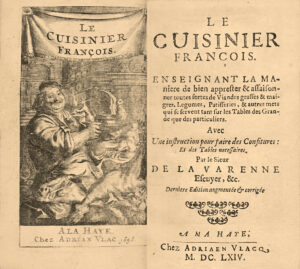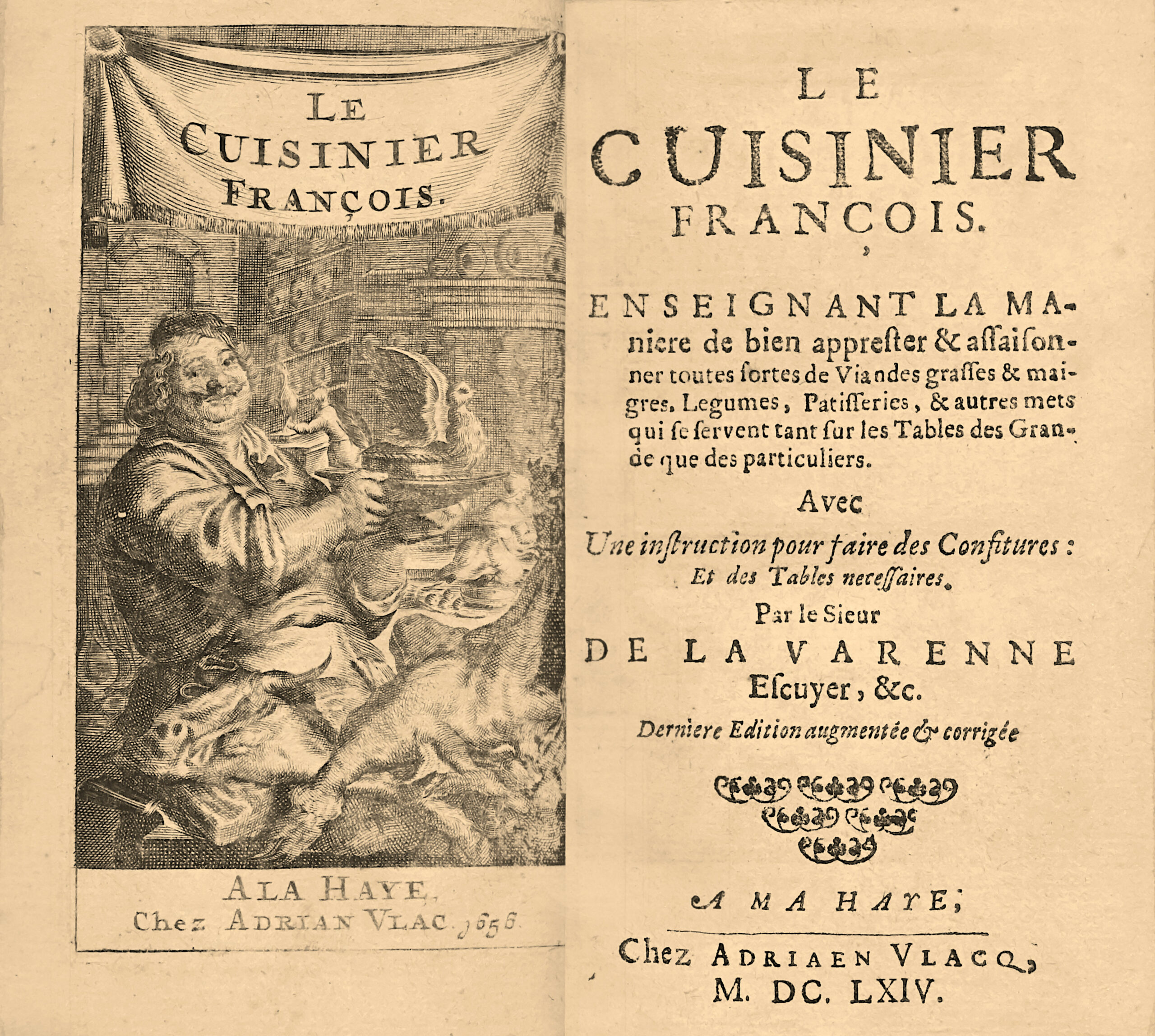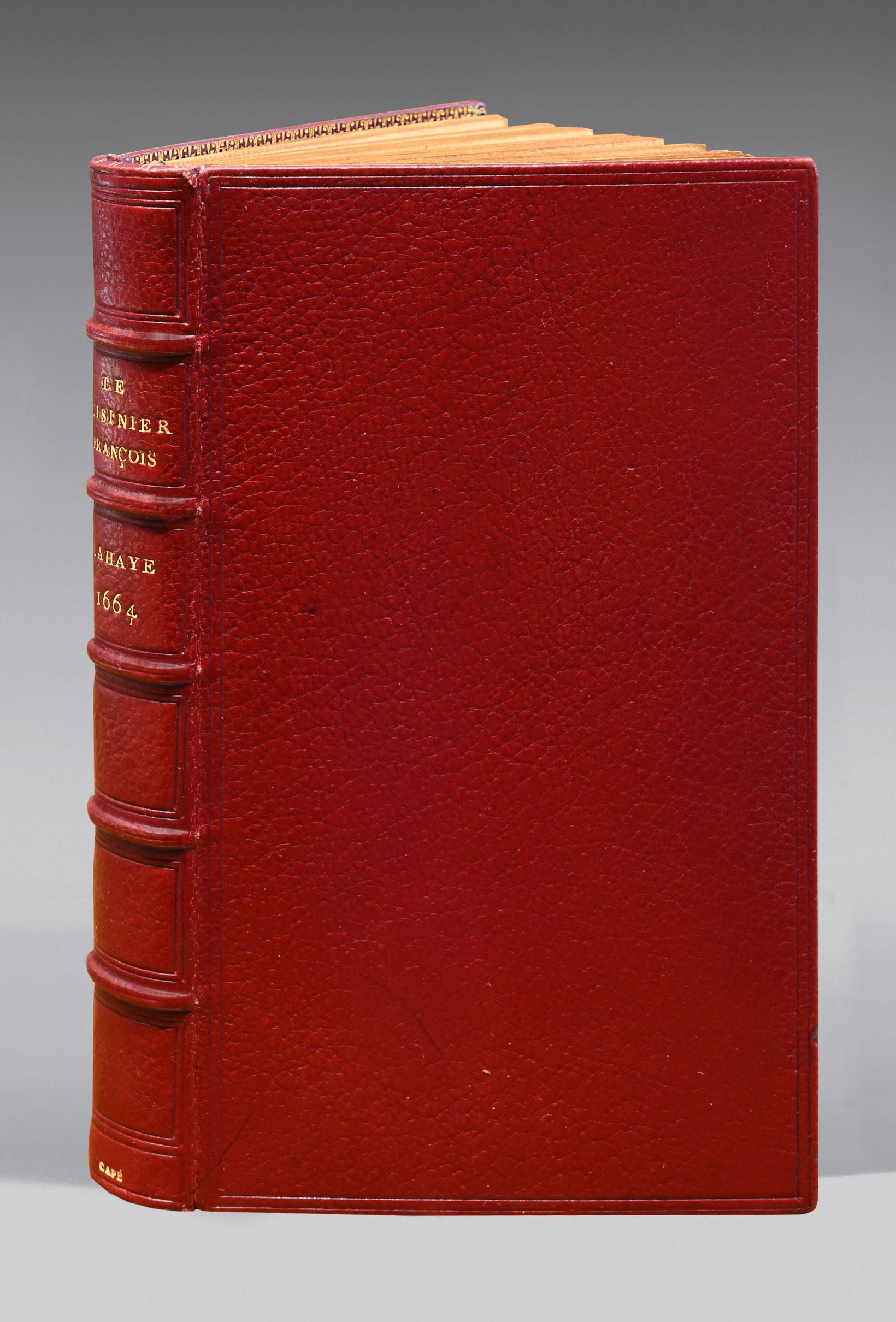La Haye (sic), Adriaen Vlacq, 1664.
Small 12mo, 6 lim. ll. including engraved frontispiece, 426 pp. and (14) ll. of table. Red morocco, double blind-stamped fillet around the covers, ribbed spine, blind-stamped fillets inside the panels, gilt inner border, gilt edges. Capé.
127 x 74 mm.
One of the mythical books of international bibliophily classified among the Elsevier collection next to the famous ‘Pastissier françois’ of 1655.
“These two editions of the Cuisinier François of 1656 and 1664 are sought after because they are placed in the Elsevier collection, next to the famous “Pastissier François”’ (Brunet III, col. 886).
“A volume that is considered to be a sort of complement to the Pastissier françois, and which for some time has risen in price in the same proportions”. (Willems, no. 1658).
In 1878, the booksellers Morgand and Fatout had the good fortune to discover, in Italy, a copy of the Pastissier François of 1655 in wrappers, untrimmed, for which they asked and obtained 10,000 gold francs (Bulletin de la librairie Morgand et Fatout, Oct. 1878 issue, n°4294), i.e. 4,000 times the price of a basic bibliophile book described at that time by Brunet.
Published a century before the golden age of gastronomy, the “Cuisinier français” is the key work of the period which has seen the gradual decline of culinary ways of the middle ages.
The “Livres en bouche” exhibition at the Arsenal library in Paris gave us the opportunity to look back at the reasons for its prodigious success.
“The market for books dealing with the “science de la gueule” (to use Montaigne’s expression) was dominated throughout the second half of the 17th century by the very orthodox work of La Varenne, until his hegemony was gradually consumed by a competitor: Massialot‘s “Cuisinier royal et bourgeois”.
“The work marks the beginning of a new era. Not only had no new cookery book been published in France for more than a century, but the recipes it suggests also show a marked evolution in taste (…) La Varenne was thus laying the foundations of a new canon of taste (…).
The work was also new in the history of taste, and in the material history of cookery books, for which it inaugurated the modern formula: it was distinguished from all its predecessors by the clarity of its layout, which followed the order in which the meal was served: soup first, then starters, roasts and entremets. This simple structure is repeated three times, according to traditional religious precepts: fat days, lean days outside Lent, Lenten season. Between these three main blocks are a few recipes for broths (…)’.
“The whole constitutes a set of approximately 700 recipes, most of which being numbered and listed in tables at the head of each course. The distinction between basic and elaborate preparations, the numbering of recipes and the appearance of tables are all new elements that tend towards a rational organization of the cookbook. By speaking in the first person, the cook became the true subject and author of his cooking’. (B.n.F., Livres en bouche, no. 106).
“These two books, Le Cuisinier français and Le Pâtissier français, enjoyed considerable success and were often republished. La Varenne hardly benefited from them and died a pauper in Dijon at the age of sixty, having left the service of the widow of the Marquis d’Uxelles, who was killed at the siege of Gravelines. He was one of the first French cooks to take an interest in vegetables, which had been despised before him, and to give original recipes for ‘accommodating them with honour and contentment’.
A whole book would not be enough to analyze La Varenne’s recipes and detail all the subtleties of his truffles in ragoust, his eggs à la huguenotte or his fricasseed asparagus.’ Gérard Oberlé.
As an example, here is his recipe for Oysters: ‘Take them out of the shell and blanch them, or as they come out of the basket, put them in a poe and season them with salt, pepper, beaten nail and a few bay leaves: cover them well, or if you like, you can stick them in a barrel. When you want to use them, desalinate them in lukewarm water. Once they have been desalted, you can garnish them or make them into baths or fricassees’.
Remarkable copy of the Cuisinier françois of 1664 described by Vicaire: ‘The copy of M. Pieters, auctioned at the sale of this bibliophile 115 r. reached, in red mor. (Capé) the price of 335 fr.; Benzon. It should be noted that in the catalogue of the books of this enthusiast this edition of 1664 is announced as having been given in The Hague by A. Flacq instead of Vlacq’. (Brunet, Supplément) I, col. 802; and Willem n° 1688 ‘l’édit. de 1664, mar. r. (Capé) h. 128 mill. 115 frs. Pieters, rev. 240 frs. De la Villestreux, and 335 frs. Benzon’.
La Varenne was the chef to the Marquis d’Uxelles, governor of Chalon-sur-Saône, and the author of Le Cuisinier françois, a major work marking the transition between the medieval cuisine of yesteryear to the great modern cuisine, and contributing to the development of culinary terminology.
Le Cuisinier françois is the first cookbook to put into practice the considerable culinary innovations achieved in France in the 17th century by codifying cooking in a methodical way, using rules and principles. It is the first cookery book in which modern readers will find recognizable recipes, such as ‘bœuf à la mode’, ‘œufs à la neige’, ‘bisque’, etc. This book contains the first mention of the bouquet garni, fonds de cuisine, reductions, the use of egg whites to clarify jellies, and so on. There are also bindings based on mushrooms, truffles and almonds. It also contains the first recipe for mille-feuilles. Vegetables are treated extensively. A recipe ‘with good fresh butter, a little vinegar, salt and nutmeg, and an egg yolk to bind the sauce’ proposed to accompany asparagus prefigures hollandaise sauce. He also mentioned for the first time professional expressions such as ‘à la mode’, ‘au bleu’ or ‘au naturel’, which have now become part of the specialist vocabulary. He invented duxelles and, above all, replaced bread-based sauces with rouxes. He replaced the use of lard with butter.
The success of Le Cuisinier françois was such that more than 250,000 copies were published in about 250 editions, and it was reprinted in France until 1815. It was the first French cookery book to be translated into English. There were pirate editions in Amsterdam and The Hague, and even an imitation, Le Cuisinier françois méthodique, published without an author’s name in Paris in 1660.
The Morgand et Fatout bookshop therefore sold 10,000 F. Or in October 1878 a copy of Le Pastissier françois.
That same year, at the Ambroise Firmin-Didot sale in June 1878, books from the finest European bibliophiles fetched the following prices:
|
651. Cervantès (M. de). El Ingenioso hidalgo, don Qvixote de la Mancha. Compuesto por Miguel de Cervantes Saauedra…. Aňo 1608. En Madrid, Por luan de la Cuesta. Vendese en casa de Francisco de Robles, librero del Rey ňro seňor. Segvnda parte del Ingenioso hidalgo… Aňo 1615. En Madrid, etc. – 2 vol. pet. in-4 ; mar. olive, tr. dor. La première partie est de la deuxième édition ; la seconde est en édition originale. La reliure de cette dernière est aux armes et au chiffre de De Thou ; on a relié le premier volume à l’imitation de celle-ci et on a appliqué au milieu les deuxièmes armes de De Thou, empruntées à un autre ouvrage. Ces deux volumes sont aujourd’hui fort rares. Très bel exemplaire, avec témoins.
|
Sold 2 500 F. or in 1878
Resold 520 000 £ on 15 May 2022 by Christie’s
|
| 94. (Homeri Opera, Grӕce.)
Florentiӕ, sumptibus Bern. Et Nerii Nerliorum, 1488. 2 part. en 1 vol. in-fol. ; mar. La Vallière, riches compart., tr. dor. (Duru). Première édition d’Homère, fort rare. La partie littéraire a été soignée par l’Athénien Démétrius Chalcondyle, et M. Didot a le premier démontré, dans son Alde Manuce (pp. 38-44), que l’exécution de ce beau monument typographique est due à Démétrius le Crétois. Magnifique exemplaire, d’une grande pureté. La reliure, dans le genre Grolier, est remarquable.
|
Sold 2 550 F. or in 1878
Current value : 600 000 €
|
|
Morgand et Fatout La Varenne. Le Pastissier françois. Où est enseigné la manière de faire toute sorte de pastisserie, très utile à toute sorte de personnes. Ensemble le moyen d’aprester toutes sortes d’œufs pour les jours maigres, et autres, en plus de soixante façons. À Amsterdam, chez Louys et Daniel Elzevier. A. 1655, pet. in-12.
|
Sold 10 000 F. or in October 1878
|
Precious copy quoted by Brunet (Suppl., I, col. 802); Willems and Vicaire, one of the two highest bids ever recorded by bibliographers.
From the libraries of C. Pieters, Baron de Belet and Léon Lambert, with ex-libris.



